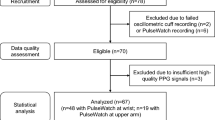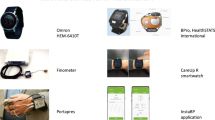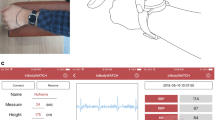Abstract
Cuffless wearable devices are currently being developed for long-term monitoring of blood pressure (BP) in patients with hypertension and in apparently healthy people. This study evaluated the feasibility and measurement stability of smartwatch-based cuffless BP monitoring in real-world conditions. Users of the first smartwatch-based cuffless BP monitor approved in Korea (Samsung Galaxy Watch) were invited to upload their data from using the device for 4 weeks post calibration. A total of 760 participants (mean age 43.7 ± 11.9, 80.3% men) provided 35,797 BP readings (average monitoring 22 ± 4 days [SD]; average readings 47 ± 42 per participant [median 36]). Each participant obtained 1.5 ± 1.3 readings/day and 19.7% of the participants obtained measurements every day. BP showed considerable variability, mainly depending on the day and time of the measurement. There was a trend towards higher BP levels on Mondays than on other days of the week and on workdays than in weekends. BP readings taken between 00:00 and 04:00 tended to be the lowest, whereas those between 12:00 and 16:00 the highest. The average pre-post calibration error for systolic BP (difference in 7-day BP before and after calibration), was 6.8 ± 5.6 mmHg, and was increased with higher systolic BP levels before calibration. Smartwatch-based cuffless BP monitoring is feasible for out-of-office monitoring in the real-world setting. The stability of BP measurement post calibration and the standardization and optimal time interval for recalibration need further investigation.

This is a preview of subscription content, access via your institution
Access options
Subscribe to this journal
Receive 12 print issues and online access
$259.00 per year
only $21.58 per issue
Buy this article
- Purchase on Springer Link
- Instant access to full article PDF
Prices may be subject to local taxes which are calculated during checkout




Similar content being viewed by others
References
Lee HY, Oh GC, Sohn IS, Park S, Shin J, Beaney T, et al. May Measurement Month 2019: An analysis of blood pressure screening results from Korea. Eur Heart J Suppl. 2021;23:B89–B91.
Lee HY, Oh GC, Sohn IS, Park S, Shin J, Pyun WB, et al. Suboptimal management status of younger hypertensive population in Korea. Korean Circ J. 2021;51:598–606.
Mehlum MH, Liestol K, Kjeldsen SE, Julius S, Hua TA, Rothwell PM, et al. Blood pressure variability and risk of cardiovascular events and death in patients with hypertension and different baseline risks. Eur Heart J. 2018;39:2243–51.
Weber MA. Blood pressure variability and cardiovascular prognosis: Implications for clinical practice. Eur Heart J. 2017;38:2823–6.
Vidal-Petiot E, Stebbins A, Chiswell K, Ardissino D, Aylward PE, Cannon CP, et al. Visit-to-visit variability of blood pressure and cardiovascular outcomes in patients with stable coronary heart disease. Insights from the STABILITY trial. Eur Heart J. 2017;38:2813–22.
Sega R, Cesana G, Bombelli M, Grassi G, Stella ML, Zanchetti A, et al. Seasonal variations in home and ambulatory blood pressure in the PAMELA population. Pressione Arteriose Monitorate E Loro Associazioni. J Hypertens. 1998;16:1585–92.
Kim KI, Nikzad N, Quer G, Wineinger NE, Vegreville M, Normand A, et al. Real World home blood pressure variability in over 56,000 individuals with nearly 17 million measurements. Am J Hypertens. 2018;31:566–73.
Bell K, Doust J, McGeechan K, Horvath AR, Barratt A, Hayen A, et al. The potential for overdiagnosis and underdiagnosis because of blood pressure variability: A comparison of the 2017 ACC/AHA, 2018 ESC/ESH and 2019 NICE hypertension guidelines. J Hypertens. 2021;39:236–42.
Silver L. Smartphone ownership is growing rapidly around the world, but Not Always Equally. Washington, DC, USA: Pew Research Center; 2019. p. Report.
Luo H, Yang D, Barszczyk A, Vempala N, Wei J, Wu SJ, et al. Smartphone-based blood pressure measurement using transdermal optical imaging technology. Circ Cardiovasc imaging. 2019;12:e008857.
Stergiou GS, Alpert B, Mieke S, Asmar R, Atkins N, Eckert S, et al. A Universal standard for the validation of blood pressure measuring devices: Association for the Advancement of Medical Instrumentation/European Society of Hypertension/International Organization for Standardization (AAMI/ESH/ISO) collaboration statement. Hypertension. 2018;71:368–74.
Vybornova A, Polychronopoulou E, Wurzner-Ghajarzadeh A, Fallet S, Sola J, Wuerzner G. Blood pressure from the optical Aktiia Bracelet: A 1-month validation study using an extended ISO81060-2 protocol adapted for a cuffless wrist device. Blood Press Monit. 2021;26:305–11.
Lee HY, Lee DJ, Seo J, Ihm SH, Kim KI, Cho EJ, et al. Smartphone/smartwatch-based cuffless blood pressure measurement: A position paper from the Korean Society of Hypertension. Clin Hypertens. 2021;27:4.
Kuwabara M, Harada K, Hishiki Y, Kario K. Validation of two watch-type wearable blood pressure monitors according to the ANSI/AAMI/ISO81060-2:2013 guidelines: Omron HEM-6410T-ZM and HEM-6410T-ZL. J Clin Hypertens (Greenwich). 2019;21:853–8.
Kario K, Shimbo D, Tomitani N, Kanegae H, Schwartz JE, Williams B. The first study comparing a wearable watch-type blood pressure monitor with a conventional ambulatory blood pressure monitor on in-office and out-of-office settings. J Clin Hypertens (Greenwich). 2020;22:135–41.
Chandrasekaran V, Dantu R, Jonnada S, Thiyagaraja S, Subbu KP. Cuffless differential blood pressure estimation using smart phones. IEEE Trans Biomed Eng. 2013;60:1080–9.
Gaurav A, Maheedhar M, Tiwari VN, Narayanan R. Cuff-less PPG based continuous blood pressure monitoring: A smartphone based approach. Annu Int Conf IEEE Eng Med Biol Soc. 2016;2016:607–10.
Stergiou GS, Mukkamala R, Avolio A, Kyriakoulis KG, Mieke S, Murray A, et al. Cuffless blood pressure measuring devices: Review and statement by the European Society of hypertension working group on blood pressure monitoring and cardiovascular variability. J Hypertens. 2022;40:1449–60.
Kim HC, Ihm SH, Kim GH, Kim JH, Kim KI, Lee HY, et al. 2018 Korean Society of Hypertension guidelines for the management of hypertension: Part I-epidemiology of hypertension. Clin Hypertens. 2019;25:16.
Verberk WJ, Kroon AA, Lenders JW, Kessels AG, van Montfrans GA, Smit AJ, et al. Self-measurement of blood pressure at home reduces the need for antihypertensive drugs: a randomized, controlled trial. Hypertension. 2007;50:1019–25.
Cappuccio FP, Kerry SM, Forbes L, Donald A. Blood pressure control by home monitoring: Meta-analysis of randomised trials. BMJ. 2004;329:145.
Little P, Barnett J, Barnsley L, Marjoram J, Fitzgerald-Barron A, Mant D. Comparison of acceptability of and preferences for different methods of measuring blood pressure in primary care. BMJ. 2002;325:258–9.
Kario K. Management of hypertension in the digital era: Small wearable monitoring devices for remote blood pressure monitoring. Hypertension. 2020;76:640–50.
Acknowledgements
MH, YRL, and TP wrote the draft. SI and WBP, the present and the immediate-past presidents of KSH, supported this study on behalf of the KSH. All authors reviewed and edited the manuscript. All authors have read and agreed to the published version of the manuscript. We thank Jongmin Choi and Sunok Jung (Samsung Electronics) for technical assistance in Galaxy Watch device instructions.
the Korean Society of Hypertension
Sang-Hyun Ihm5, Wook Bum Pyun6, Hae Young Lee1,2, Myeong-Chan Cho8
Author information
Authors and Affiliations
Consortia
Contributions
The authors indicated in parentheses made substantial contributions to the following tasks of research: initial conceptualization (WBP, HYL, JMS, TB); study design (HYL, JMS, TP); literature search and data collection (MH, SHI,HYL); data analysis (YRL, TP, JMS); data interpretation (MH, YRL, TP, JMS, HYL, TB, MCC, MC, EY, GSS); and writing (MH, YRL, TP). All authors have read and agreed to the published version of the manuscript. MH, YRL, and TP contributed equally to this work and share first authorship.
Corresponding author
Ethics declarations
Conflict of interest
GSS has received honoraria for lectures at scientific symposia and for consulting services and research grants from several manufacturers of blood pressure monitoring technology including manufacturers of cuffless devices Aktiia SA, Maisense, and Samsung Research America, Inc. The other authors declare no conflict of interest.
Additional information
Publisher’s note Springer Nature remains neutral with regard to jurisdictional claims in published maps and institutional affiliations.
Supplementary Information
Rights and permissions
Springer Nature or its licensor (e.g. a society or other partner) holds exclusive rights to this article under a publishing agreement with the author(s) or other rightsholder(s); author self-archiving of the accepted manuscript version of this article is solely governed by the terms of such publishing agreement and applicable law.
About this article
Cite this article
Han, M., Lee, YR., Park, T. et al. Feasibility and measurement stability of smartwatch-based cuffless blood pressure monitoring: A real-world prospective observational study. Hypertens Res 46, 922–931 (2023). https://doi.org/10.1038/s41440-023-01215-z
Received:
Revised:
Accepted:
Published:
Issue Date:
DOI: https://doi.org/10.1038/s41440-023-01215-z
Keywords
This article is cited by
-
History and evolution of blood pressure measurement
Clinical Hypertension (2024)
-
The reality and serendipity of cuffless blood pressure monitoring
Hypertension Research (2023)



